|
 Entoloma hochstetteri Entoloma hochstetteri
SynonymsCortinarius hochstetteri
Hygrophorus hochstetteri
Hygrophorus cyaneus
Hygrophorus azureus
Entoloma virescens
BiostatusPresent in region - Indigenous. Non endemic
Images (click to enlarge)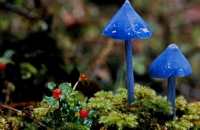
Owner: George Barron | 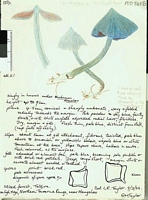
Caption: Watercolour
Owner: G.M. Taylor | 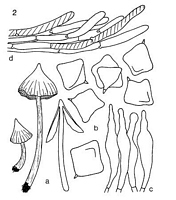
Caption: Entoloma hochstetteri (Reich.) Stev.
(Herb. Hk.68/73): a. carpophores. b. spores. c. cheilocystidia. d. cuticle. | 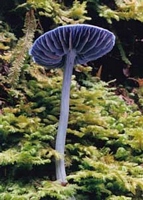
Caption: Entoloma hochstetteri
Owner: Kaimai Bush | 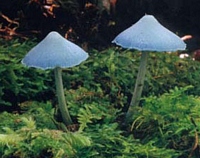
Caption: Entoloma hochstetteri
Owner: Kaimai Bush | 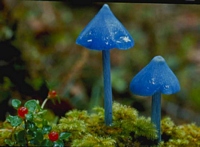
Owner: George Barron | 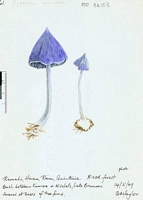
Caption: Watercolour
Owner: G.M. Taylor | 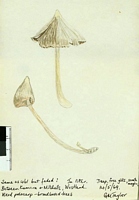
Caption: Watercolour
Owner: G.M. Taylor | 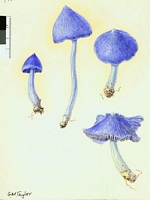
Caption: Watercolour
Owner: G.M. Taylor | 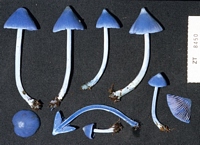
Caption: PDD8450: Entoloma hochstetteri
Owner: Egon Horak | 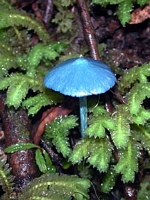
Owner: J.A. Cooper | 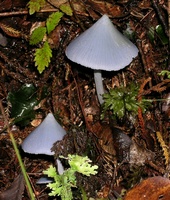
Owner: J.A. Cooper | 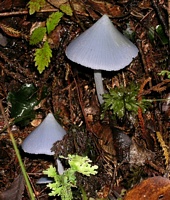
Caption: FUNNZ2007/0375
Owner: FUNNZ |
Article: Horak, E. (1973). Fungi Agaricini Novazelandiae I-V. Beihefte zur Nova Hedwigia 43: 200 p.
Description: Pileus
15-50 mm diam., conical to sharply umbonate, edge inturned (even in aged carpophores),
light blue turning greenish blue and finally ochraceous coloured near the apex,
hygrophanous, striate towards the margin, dry, appressed fibrillose. Lamellae
adnexed or subfree, bluish when young, becoming bluish-reddish brown to pink
brown, moderately crowded, gill edge concolorous, even or irregularly scalloped.
Stipe 50-100(-150) x 3-5 mm, cylindrical,
equal or attenuated upwards, concolorous with pileus, fading to brownish, whitish
at the base, dry, fistulose, fragile, fibrillose, frequently twisted. Context
bluish or bluish-greenish (especially at the base). Odor and taste indistinct.
Chem. reactions: on pileus: KOH - light reddish-brown; HCl yellowish; NH3-
negative.
Spore
print purplish or deep red-brown. Spores 11-15 x 11-14 µm, cuboid. basidia 40-60
x 15-20 µm, 4-spored. Cheilocystidia 40-60 x 8-14 µm, fusoid, with long tapering
and apically rounded neck, membrane thin-walled. pleurocystidia none. Cuticle
a cutis composed of repent or slightly suberect, cylindrical hyphae (5-13 µm
diam.), terminal cells rounded, membrane thinwalled, with indistinct plasmatic
pigment. Clamp connections present.
Habitat: Among
litter and moss on soil particularly in broad-leaved forests and Podocarpus-forests,
rarely occurring in Nothofagus-bush. New Zealand.
Notes: This
fungus is common in the lowland-forests of New Zealand, especially on the western
side of the three islands. The pale blue or greenish colours of this beautiful
Entoloma attracted the interest of all collectors (Haast, Hochstetter,
Colenso, Berggren) since the very beginning of botanical investigations in this
country (see Stevenson 1962: I.c.). So it is not surprising that the species
was subsequently described several times (see list of synonyms).
According
to our present knowledge, the closest relatives of E. hochstetteri occur
in Japan (Imazeki & Hongo 1962) and North America (Hesler 1967).
Article: Horak, E. (1990). Monograph of the New Zealand Hygrophoraceae (Agaricales). New Zealand Journal of Botany 28(3): 255-306 (http://www.rsnz.org/publish/abstracts.php).
Notes: There is no type material in the Kew Herbarium but the taxon is well documented
with a painting executed by J. V. Haas (cf. Stevenson, 1962: 234; Horak, 1971:
417).
Article: Massee, G.E. (1899) [1898]. The fungus flora of New Zealand. Transactions and Proceedings of the New Zealand Institute 31: 282–349 Wellington:.
Description: Entirely clear sky-blue. Pileus acutely conical, splitting, slightly striate, 4 cm. high; gills free,
very broad (1 cm.) in front, gradually narrowing to the stem ; stem 12 cm. high, 7-8 mm.
thick, hollow, base thickened.
Habitat: Middle Island: Beech forests, amongst moss, Nelson Province. Julius Haast.
Notes: The present species is somewhat uncertain, being described by Berkeley from a crude
drawing only. To this species Cooke refers a drawing of a Fungus from Waitaki, with the
following remark : "The colour as shown in the drawing is verdigris-green, but in other
respects it does not appear to differ from the typical form in any essential particular."
Article: Cooke, M.C. (1879). New Zealand fungi. Grevillea 8(46): 54-68.
Notes: The colour as shown in the drawing is verdigris-green, but in other respects it
does not appear to differ from the typical form in any essential particular.
Article: Horak, E. (1971). A contribution towards the revision of the Agaricales (Fungi) from New Zealand. New Zealand Journal of Botany 9(3): 403-462 (http://www.rsnz.org/publish/abstracts.php).
Notes: Hygrophorus cyaneus Berkeley (3 D, 4, 16, 27) = Entoloma hochstetteri
(Reichardt) Stevenson
No specimens have been preserved but a well executed painting of this
distinctive fungus by J. V. Haast exists at Kew. For further details see Stevenson
(27).
Article: Horak, E. (1971). A contribution towards the revision of the Agaricales (Fungi) from New Zealand. New Zealand Journal of Botany 9(3): 403-462 (http://www.rsnz.org/publish/abstracts.php).
Notes: The poor state of the exsiccaturn (N.Z., Dr Berggren) did not allow detailed
observations, but there is no doubt that this species belongs to Hygrophorus, as
already stated by Stevenson (28).
|